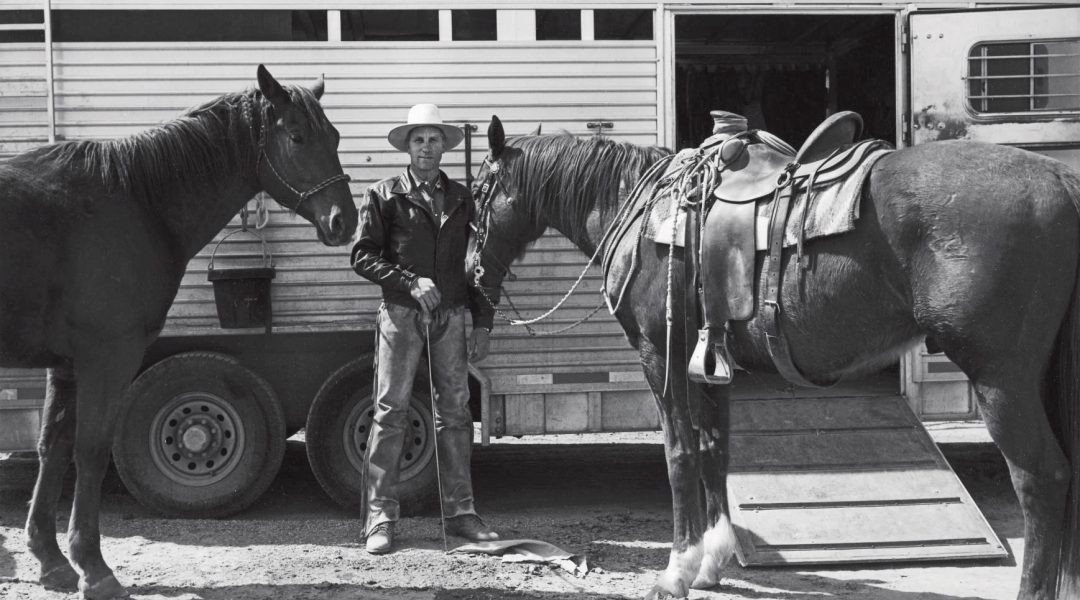A trained architect, this Arizona photographer knows cowboys best.
If there’s truth in the old saw “it takes one to know one,” then Jay Dusard knows cowboys. The Illinois-raised photographer bought his first horse in 1962 while he was training in the U.S. Army at Fort Hood, Texas, and he spent every free moment punching cows for the ranchers who grazed cattle there. His first job out of the military was wrangling cattle for $7 a day in Arizona on part of the historic Slaughter Ranch, and he’s owned horses and worked cattle ever since.
As much as the subject is a natural fit for him, the medium itself was an accident. While studying architecture at the University of Florida, Dusard signed up for a painting elective instead of the more popular photography course. Then somebody handed him a book by the abstract expressionist photographer Aaron Siskind.
“I saw that work and I made a promise to myself,” Dusard recalls. “Someday I would take up photography and get good at it. After that I went to Tucson [Arizona], went to work for an architect, and took up photography.” But it didn’t take long for Dusard to realize that living in a city and running a business wasn’t for him. As he drifted away from architecture, photography took its place. He studied all of Ansel Adams’ books and took one of Adams’ Yosemite workshops before catching the eye of photographer Frederick Sommer.
“I lived in Prescott — his town — for quite a few years,” Dusard says. “I learned a lot of camera techniques, learned a lot about lenses, and learned a lot of darkroom techniques from him.” But it was photographer L.A. Huffman who helped connect the dots between Dusard’s two passions.
“[Huffman] photographed a lot of cowboys for a book called Before Barbed Wire,” Dusard says. “Somehow I stumbled onto that. It was still photographs set up on a tripod for the most part. Working primarily with an 8 x 10 [camera], I thought I could go out and find these cowboys and do formal portraits of them with the equipment I knew best. So I wrote that up as a proposal to the Guggenheim Foundation and they gave me a 1981 fellowship.” The result was The North American Cowboy: A Portrait (Consortium Press, 1983).

Dusard is building on his seminal work with a new digital book titled Vaqueros & Buckaroos: Photographs from 1970 to the Present. Some of the material in Vaqueros & Buckaroos was shot while Dusard was working on The North American Cowboy. “I carried a 35 mm camera with color transparency film,” Dusard says. “I wanted a record of where I had been, who I’d been with, and what we had done. A lot of that shows up in [Vaqueros & Buckaroos]. And then there are landscapes, which help define the place where these people rode and worked cattle.”
In more than 200 photographs, Vaqueros & Buckaroos traces the historical trajectory of the vaquero up through California, Nevada, Oregon, and into Canada, beginning with the introduction of cattle to Mexico by the Spanish. Dusard documents the people who still work in the vaquero tradition. Grounded in European classical horsemanship and nurtured in a climate with few constraints, the unique style is described by Dusard as “decorative elegance in dress and gear, plus elegance and finesse in horsemanship and livestock handling.”
Like the vaqueros he photographs, Dusard strives to ride and work in an unhurried, careful manner. He built his reputation shooting 8 x 10 because it forced him to work slowly, accurately, and contemplatively. Only his current choice to go digital gives the traditional work an unexpected twist. None of the images were captured digitally, however; they are a combination of 8 x 10, 4 x 5, medium format, and 35 mm transparencies that have been digitally scanned.
As for his decision to shoot exclusively in black-and-white, Dusard once pointed out that it’s based on his vision of the world. “I keep telling myself and others that I really see in black-and-white. I think I pretty much do. ... If the subject is fairly realistic, the viewer is going to add the color. They’re not going to feel like they got cheated, but they are going to provide a lot of the visual experience for themselves.”
Now 74, Dusard hasn’t let a recent triple bypass slow him down. Last October found him winning gold for works on paper at The West Select, the fall art show and sale at Phoenix Art Museum, and looking forward to helping friends with the fall roundup near his Douglas, Arizona, home.
“I’m a real addict to working cattle,” he says. “I like to think that has given me credibility.”
Jay Dusard’s digital photography book, Vaqueros & Buckaroos: Photographs from 1970 to the Present, will be available at www.jaydusard.com and www.vaqueros&buckaroos.com. Print editions of his books are available at Amazon.com and include: The North American Cowboy: A Portrait (Consortium Press, 1983), La Frontera: The United States Border with Mexico with Alan Weisman (University of Arizona Press, 1991), Open Country (Gibbs Smith, 1994), and Horses with Thomas McGuane (Rio Nuevo, 2005).
From the March 2012 issue.














